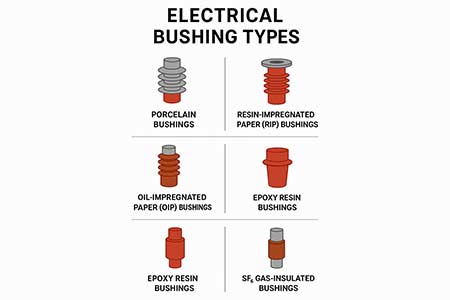Electrical bushings are essential components in power transmission and distribution systems, designed to allow conductors to pass safely through grounded barriers such as transformer tanks, circuit breaker housings, or switchgear enclosures. Their main function is to provide insulation and mechanical support while preventing electrical faults caused by direct contact between the conductor and grounded parts.
There are several common types of electrical bushings, each suitable for different operational environments and voltage levels:
☆ Porcelain Bushings – Widely used for outdoor applications due to their durability, weather resistance, and good insulating properties.
☆ Resin-Impregnated Paper (RIP) Bushings – Known for their compact structure, moisture resistance, and stable dielectric performance, making them suitable for high-voltage transformers and GIS systems.
☆ Oil-Impregnated Paper (OIP) Bushings – Common in high-voltage power transformers, offering reliable insulation and heat dissipation, though requiring regular maintenance.
☆ Epoxy Resin Bushings – Lightweight, customizable, and resistant to pollution, ideal for compact switchgear and indoor installations.
☆ SF6 Gas-Insulated Bushings – Used in GIS equipment where space is limited and high dielectric strength is required.

When selecting an electrical bushing, it is important to consider factors such as voltage rating, operating environment, mechanical strength, and ease of maintenance. A well-chosen bushing can enhance system reliability, reduce downtime, and extend equipment service life.
Putai offers a range of electrical bushings designed for medium and high-voltage applications, focusing on dependable performance and long-term stability. Our products are engineered to meet industry standards and support diverse project requirements.